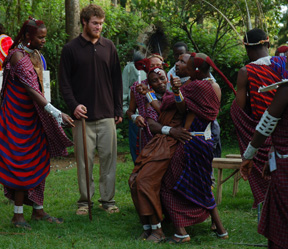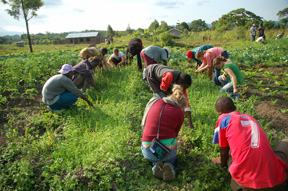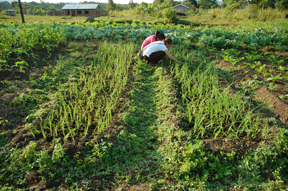Our first experience of true Maasai culture, although I doubt we could call our excursion completely authentic as we weren’t asked to drink the blood of a sacrificed goat. Kumo, a sister group to Letoa which is an Arusha Project parter organization, is based up in the hills just outside of town. (Side note: It’s amazing the increase in population of bugs as you go to higher elevations in the thick of the forest.) Two Maasai men met us at the entrance and brought us up a little walkway to their main back yard where a group of nearly 20 Maasai women and men fully clad in traditional Maasai blankets and ornate beaded jewelry greeted us with song and dance.

The people of Kumo, we were told, live a self-sustainable lifestyle on this farm and publicly sing about the issues and consequences of HIV/AIDS to promote education and testing of the disease. Locally, the Maasai members grow all of the food that they need to live as well as some coffee crops for resale and have mastered agricultural skills like grafting to produce marketable fruit trees. They capture biogas from the dung of their cows to fuel their stoves and electricity. After walking around their visitor grounds, we were presented with “supper” consisting of potatoes, lentils, eggs, etc. that was harvested on their land and another Maasai dance performance. This time, as Joachim (founder of Letoa, the head organization of Kumo) explained, they were performing a special dance in which a man seeks out a woman and eventually puts himself into a crazed trance-like state. As we watched, the dance master began to loose control, convulsing in the captive arms of the other male dancers who brought him over to the side and after 10 minutes of his constant screams, were able to fully calm him down and bring him back to a normal state.

By the end of our visit, not one of us escaped attempting Maasai dance, although Justin was by far the most enthusiastic, and quite a good jumper as it turns out.
-Kaia
Thursday night, we had our first batik making class. Turns out, it’s a lengthy process with a lot of required skill. No matter how cool our batiks turned out, I don’t think any of us created what we had envisioned.

The process starts out with sketching a drawing on cotton cloth and applying a colored gradient with ink and water to set the background. Wax is applied to areas to preserve certain areas and create a design. Gradually more and more ink is applied to darken sections while the wax keeps areas light. In each stage, the fabric must be completely dried before proceeding. At the end, the wax is cracked and dark ink is rubbed into the fissures for a classic finish.
-Kaia
Thursday, we visited Tupendane in Maji ya Chai (water of tea, appropriately named because of its brownish color), the sister organization of CCF, which is Nikki’s volunteer placement. CCF, located in town, reaches out to street kids and orphans as well as children that are being mistreated in their homes. Children stay at CCF for an average of three months and are given room and board, education and counseling. The goal is to resolve conflicts in the home and allow these children to return or train them towards a job to be self-sustainable. If this doesn’t work, the children are moved to Tupendane, a more rural location, to live and study with colleagues.Here, at Tupendane, the grounds look like a small farm. As we stepped out of the car, we saw colorful birds jumping around in the grass, a very large bull in the center of the commune, and various brick and cement buildings with bright blue doors. After greetings with the headmaster and thoroughly signing the visitors book (every organization has a book that visitors must sign, I’m not sure why, but they regard it as very important), we headed out to their garden. Behind the living quarters sits a decently sized garden planted with everything from cabbage and carrots to onions and pumpkins. Adam, the Tupendane Center manager, first explained that the goal of the project is to teach themselves and others how to grow plants in a healthy manner for consumption and ultimately become an organic farm. He stressed that small farmers will often harvest their crops soon after using pesticides instead of waiting the required 1-2 weeks for the pesticides to neutralize and become less harmful. It’s a huge health problem, but the markets are full of produce grown this way.

We’d come to learn about the organization and help weed the garden and already a host of teen boys were working at one end of the land. Right away, Jenn (our resident farmer) noticed the mass amounts of weeds propagated throughout the cultivated areas. These weeds, which grow much more rapidly in the rainy season, not only use up water intended for the planted crops but also suck necessary nutrients from the soil. On our hands and knees, we joined the boys and all started pulling and by the end or the session, made a significant dent in their weed population.

It’s not a secret that Africa’s crops aren’t all that competitive on global markets, but in a lush area like Arusha, there doesn’t seem to be any reason why they shouldn’t be. Adam, a bottomless reservoir of local knowledge, seemed to think this is due to the lack of organization and consistency amongst farmers. In an area, there may be hundreds of small farmers growing similar crops (common crops include corn, collards, cabbage, potatoes, tomatoes, etc.) but they all use different varieties and plant their crops at different times. Individual farmers don’t coordinate to produce the same strain of a crop with the same harvesting time, so they aren’t able to export their crops in any sort of quantity, thus making their produce not very marketable outside of their small localities. Adam explained that this lack of organization makes the creation of an agricultural industry next to impossible.
That’s not the end to the challenges local farms face. Last week, Jenn educated us on the details of hybrid seeds. Although hybrid seeds may produce more ideal plants that contain the most desired qualities from 2 or 4 different strains, you cannot save the seeds from these plants as the seeds will revert back to one of the weaker parent strains, or may even be engineered by hybrid seed companies to be infertile. While creating an industry that feeds income into these seed companies, local farmers only become increasingly dependent on buying new seeds each year instead of being able to maintain their own cycle of regenerating seeds. In this area, many local people don’t know how to effectively and sustainibly cultivate their land as the majority of the population aren’t historically farming tribes and have tended more towards hunter/gatherer lifestyles. So now, common farming practices that some populations may do naturally such as crop rotation, composting and strategic planting to reduce pest populations and maintain balanced soil nutrients are foreign concepts and locals aren’t getting close to the maximum yield from their land.
Tupendane is making an impressive effort to tackle these issues while support a group of give or take 30 boys that would not otherwise have a home or be able to go school. We left Maji ya Chai with a big bag of rice to feed their members, many promises to return and Jenn’s vow to help them improve their agricultural practices.
-Kaia